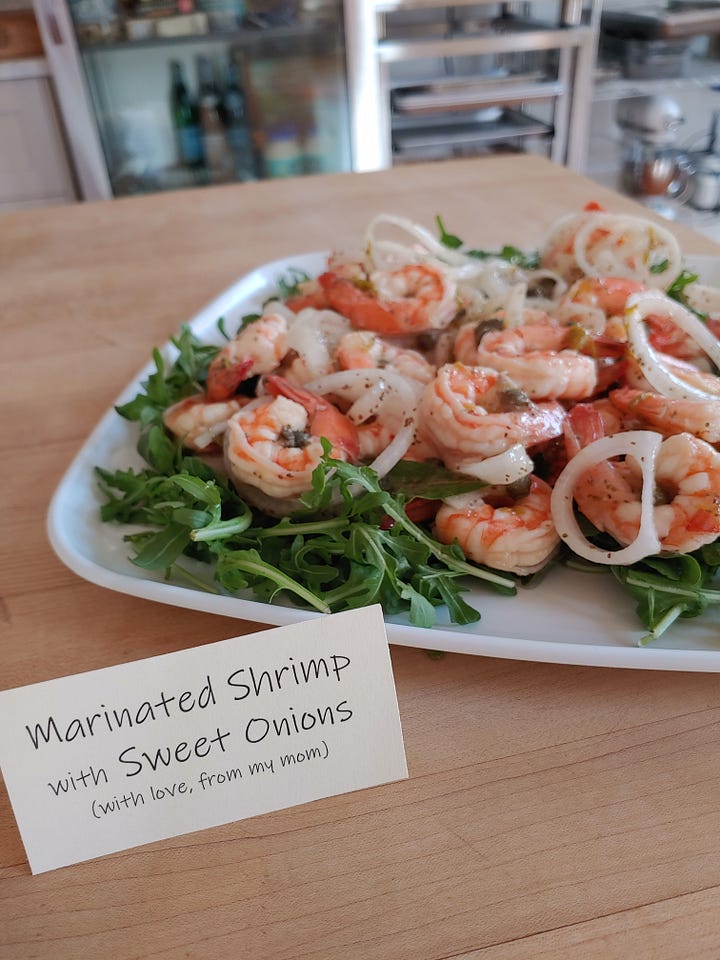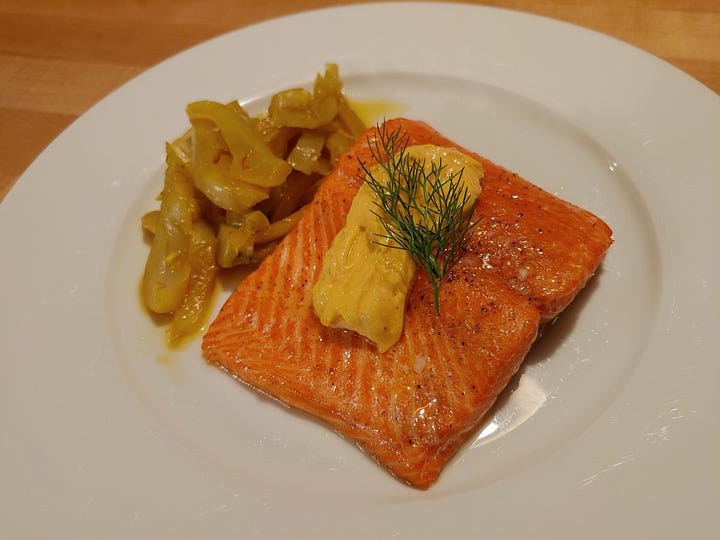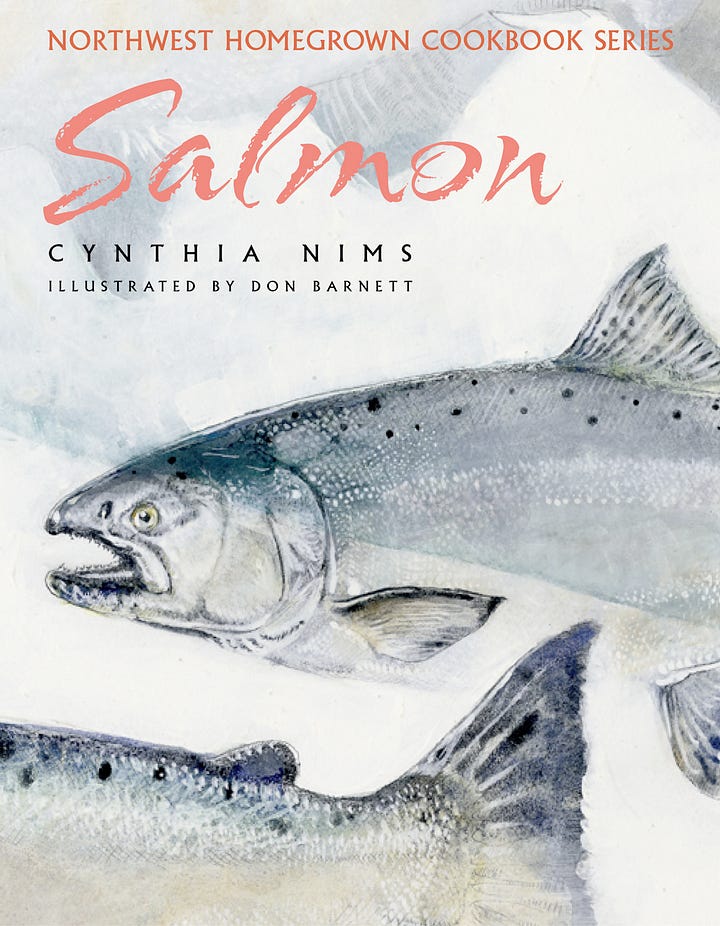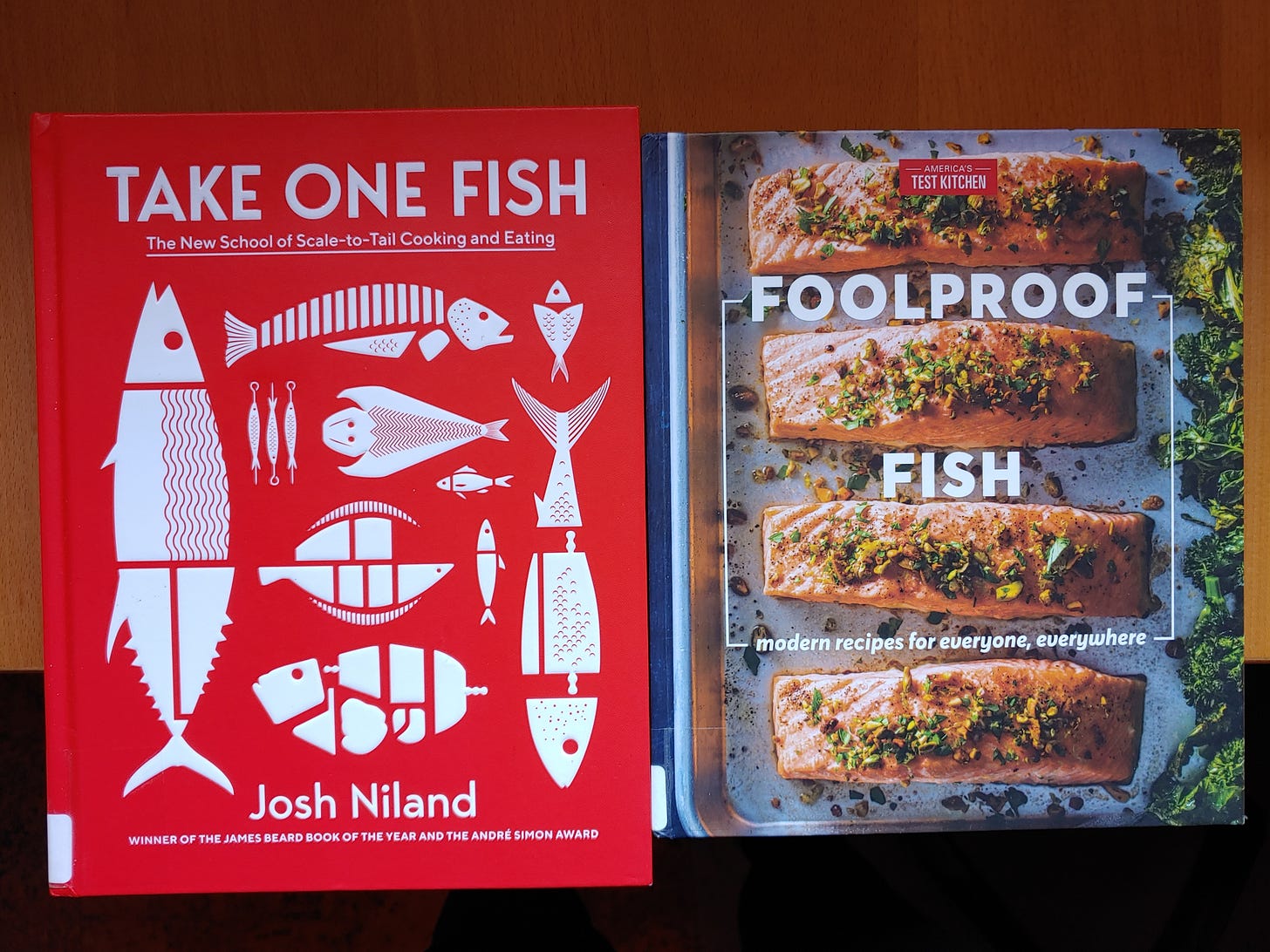Seafood Cookbooks
My intro to cookbooks, what’s on my shelf and Salmon with Saffron-Braised Fennel and Smoked Paprika Aioli
As both a cookbook author and a cookbook lover, I’m grateful earlier hints that ebooks and online recipe sources would be the demise of old-school cookbooks have proven untrue. Cookbooks remain ready to have their pages splattered and dog-eared, ready to adorn our kitchen counter or bedside table. Ready to serve up their particular story being told across the recipe collection, reflecting the personality, expertise, history, and perspectives of the author(s) as only the curated content of a book can. We can rely on cookbooks for both guidance and diversion, to flip through for tonight’s dinner menu, for fun, for ideas fueling future meals, or for no particular reason at all. No wifi, search terms, or scrolling required.
In my mom’s kitchen when I was a kid, cooking rarely started with pulling a cookbook off a shelf. My mom was either cooking something by rote, it was so familiar to her, or turning to her trusty recipe folder stuffed with recipes from many sources: family, friends, newspaper and magazine clippings, product packages (cut from the side of a box, the wrap for baking chocolate). Two of the books that she did have are in my collection today: the ring-bound 1953 Better Homes & Gardens New Cookbook and a well-worn 1946 edition of Joy of Cooking. It only recently occurred to me that, as a Navy family, it made sense to not be packing up boxes of books with each move. Her big accordion file of recipes—as stuffed as it was—was much more practical.
Though I spend far more time in her falling-apart recipe file when searching for family-oriented recipes, I can still get lost paging through these books, looking for the telltale spatter stains and dog-eared pages of her favorite recipes among them. Maybe even notes she made, such as a hand-written Yorkshire Pudding recipe she added to the opening page of a meat section, attributing it to “Nancy McWilliams, Idaho Falls, 1958”. And “The Greatest” she wrote alongside the recipe for “Snack-Style Shrimp” in the Better Homes & Gardens book, which inspired a recipe I included in my recent book Shellfish.


My first glimpse into the world of making cookbooks was the serendipitous introduction I got to Susan Herrmann Loomis. This came at a time when among my dreams were being a food writer and going to cooking school in France. It was also a time when I was a receptionist at a nonprofit in downtown Seattle, waiting to figure out what to do with myself after graduating with majors in mathematics and French. Susan had started work on her The Great American Seafood Cookbook project and could use a little help around the office. I had the great fortune to work with her a couple of afternoons a week for a couple years.
I had no idea what might lie ahead, no clue that I might one day write cookbooks myself. It was a significant turning point, one for which I’m eternally grateful to Susan. Not only did I gain inspiration watching a pro in action, she also encouraged me to apply for the stagiaire program (akin to work-study) at La Varenne cooking school in France, which she’d also done. Within a year or two I followed in those footsteps, staying on to work with the school’s founder, Anne Willan, on a number of cookbooks after I graduated. What amazing on-the-job training I got in all the moving parts of cookbook work. I was hooked.
More cookbooks tales to come……
On My Shelf
My seafood collection spans about 1 1/2 shelves of that bookcase in my office pictured above. Far from an exhaustive collection, it’s a mix of older books (some of which I turned to while editor at Simply Seafood magazine ages ago), others spanning the decades since. In this issue a few months ago I wrote about the new seafood cookbook from Hog Island Oysters in California, and there you’ll also find a great, quick squid recipe from the book. Do you spy Seafood Cooking for Dummies among the titles on my shelf? I served as the technical reviewer for that book. Like other Dummies books, it addressed seafood cooking in a super approachable and unintimidating fashion.
I have neither the shelf space nor the book-buying budget to add all the new seafood books to this assorted collection, much as I’d love to. A dedicated library patron, I’ve been checking out many new (or at least new-to-me) seafood books that cover the gamut from the very practical Foolproof Fish from America’s Test Kitchen to the avant-garde ‘scale to tail’ style of Josh Niland in his books Take One Fish and The Whole Fish. Here’s a link to Josh as guest on KCRW’s Good Food a couple years ago, a good introduction to his approach with the books. His books are striking, interesting, well-written, and with great perspectives on sourcing, prepping, storing, etc. His whole-fish approach means some recipes are rather adventurous, using cuts and parts not easily available. There is plenty in the books that captures our attention and expands our perspectives on seafood.
I have an untested theory about seafood cookbooks, one that I might have mentioned before. In the last few years I began to wonder if most people who cook seafood now and then content themselves with turning to other cookbooks versus relying on seafood-specific cookbooks for inspiration and recipes. I certainly do the same, finding interesting new ideas in any number of books. One example is a recent book from my friend Martha Holmberg, Simply Tomato. Among all those enticing recipes that celebrate the tomato are a couple with seafood that I’ve flagged, including Grilled Whole Fish with Tomatoes, Black Olives, and Parsley-Mint Pesto. BTW, the Tomato-Gruyère Galette recipe in that book is outstanding.
Another example is The Pie Room cookbook by Calum Franklin. Gorgeous works of art, many of those pies are, drawing from the English tradition of savory pies (I’ve got Holborn Dining Room, from whence the chef/author hails, on my list for a next trip to London). The “Fish and Shellfish Pies” chapter doesn’t disappoint, the first recipe I’ll dive into is The Ultimate Fish Pie, vaguely cottage-pie-like, 3 or 4 types of seafood topped with rich mashed potatoes. It looks utterly comforting and divine.
Just as we don’t need to go to a seafood-centric restaurant to have a fabulous seafood dining experience, there are a great many wonderful seafood recipes to be found in cookbooks of all types. And for those particularly enamored of seafood who want a bounty of reliable recipes at hand, and for those times when more detailed techniques, tips, and expertise are needed, a selection of great seafood cookbooks in the mix is a plus.
** I would love to hear about some of the books you turn to regularly for seafood recipes, whether seafood-focused books or not. Please let me know of some favorite titles—and maybe a favorite recipe or two from them—in the comments below.
Salmon and Saffron-Braised Fennel with Smoked Paprika Aioli
Digging back into one of my earlier cookbooks for this, it’s from Salmon in my Northwest Homegrown Cookbook Series. Unlike the rosemary-roasted crab recipe I shared a couple of issues ago—which I’ve cooked many times over the years since I first wrote it—this is one I hadn’t made in quite some time. It was written long enough ago that I included a couple of sentences about smoked paprika in the headnote, before that became a far more common ingredient. And it’s another occasion when I see how my cooking and recipe-writing styles evolve over the years. In this case, I’d originally oiled the foil before adding the fish. I no longer do so when baking or broiling skin-on fish, so the skin intentionally sticks to the foil and it’s easy to slip your spatula between the flesh and skin for serving. I prefer salmon skin that’s crispy, as when grilled or pan-fried, not easily accomplished when baking.


As referenced in the original headnote, the flavors hint a bit at the aromatic bouillabaisse from Provence, with garlic, fennel, saffron, and a splash of Pastis. It’s been a long time since I’ve made that luscious stew, richly generous with a range of seafoods and so much flavor. For a time, when we regularly hosted New Year’s Eve parties, it was how we capped off the evening, ladling out bowls of bouillabaisse to share with friends right after we’d rung in the new year.
If you have saffron and/or Pastis on hand, you’re living the good life. By no means feel that you need to buy either for this recipe to be a success (I suggest adding a bit more stock or water in those spots below). Unless, of course, this is just the opportunity you’ve been looking for to do so. I cooked this a couple of days ago without Pastis, I rarely cook with alcohol these days, since my husband developed an allergy to it. And I happen to have saffron on hand from a recent trip to Spain, an ideal chance to use that. There is still plenty of aromatic flavor to be had with the salmon, fennel, garlic, and aioli.
2 large fennel bulbs
2 tablespoons olive oil
1/2 cup salmon stock, fish stock, or water
2 tablespoons plus 2 teaspoons Pastis or other anise liqueur (optional)
1 large pinch saffron threads, steeped in 2 tablespoons warm water (optional)
1 teaspoon minced garlic
4 salmon fillet pieces (6 to 8 ounces each), pin bones removed
Smoked Paprika Aioli
1 egg yolk
1 tablespoon white wine vinegar
2 cloves garlic, finely chopped
3/4 cup olive oil (not extra virgin)
1/2 teaspoon smoked paprika
Kosher salt and freshly ground white or black pepper
For the smoked paprika aioli, combine the egg yolk, vinegar, and garlic in a food processor (preferably mini) and pulse to blend. With the blades running, begin adding the oil a few drops at a time until the yolk mixture starts to thicken, showing that an emulsion is beginning to form. Continue adding the oil in a thin, steady stream. When all the oil has been added, add the smoked paprika with a generous pinch of salt and few grindings of pepper and pulse a few more times to evenly mix. Transfer the aioli to a bowl, cover, and refrigerate until ready to serve. The aioli will have a more pronounced flavor if made a couple of hours before serving.
Preheat the oven to 375°F. Line a rimmed baking sheet with a piece of foil.
Trim the stalks from the fennel bulbs and pick off some tender fennel fronds to use as garnish. Halve and core the fennel bulbs and cut them with the grain into 1/4-inch slices. Heat the olive oil in a large skillet over medium heat. Add the fennel with a good pinch of salt and sauté until beginning to soften, 5 to 7 minutes, stirring often. Add the stock, 2 tablespoons of the Pastis (or stock or water), the saffron and its soaking liquid (or 2 tablespoons stock or water), and garlic and stir to evenly mix. Cover the skillet with its lid or a piece of foil, reduce the heat to medium-low, and cook gently until the fennel is tender and the liquid is reduced by about three-quarters, about 15 minutes.
Meanwhile, drizzle the remaining 2 teaspoons of the Pastis over the salmon pieces and rub with your fingers to evenly coat. Season the salmon with salt and pepper and set the pieces skin-side down on the prepared baking sheet. Bake the salmon until just a touch of translucence remains in the center of the thickest part, 6 to 10 minutes depending on the thickness of the fish.
To serve, slide a spatula between the flesh and skin of the salmon and transfer the salmon pieces to individual plates. Spoon the braised fennel with some of its cooking liquids alongside. Top the salmon with a generous dollop of the smoked paprika aioli and a tuft of fennel fronds. Serve right away.
Makes 4 servings







"My first glimpse into the world of making cookbooks was..."
Love, love this offered glimpse behind the curtain, a bit of your origin story.
Thanks for all these great seafood, and other, cookbook recommendation. And, thanks for the London place to see-hope to go there in the next few years, and that it will still be there!